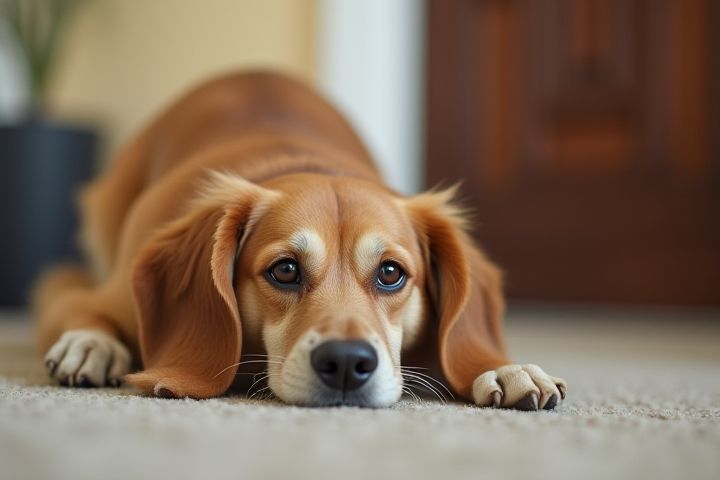
A pet-friendly house incorporates durable flooring materials like tile or laminate that resist scratches and stains while allowing for easy cleaning. Secure outdoor spaces, such as fenced yards or balconies, provide safe areas for pets to roam and play, reducing the risk of escapes or injury. Adequate ventilation and temperature control ensure a comfortable environment for pets, especially in extreme weather conditions. Designated pet areas, like cozy nooks or crates, promote a sense of safety and belonging, essential for your pet's well-being. Finally, access to pet-friendly furniture and decor, such as washable slipcovers and chew-resistant materials, enhances both aesthetics and functionality in your home.
What Makes A House Pet-Friendly
Non-toxic plants
Creating a pet-friendly home involves incorporating non-toxic plants that enhance your space while ensuring the safety of your furry friends. Popular non-toxic options include spider plants, Boston ferns, and areca palms, all of which can thrive indoors and add vibrant greenery. Consider placing these plants in areas that are accessible to your pets but not easily chewed, as even non-toxic varieties may cause minor digestive disturbances if ingested in large quantities. By choosing safe plants, you can create a visually appealing environment that supports your pets' well-being and minimizes health risks.
Durable flooring
Durable flooring materials, such as tile, vinyl, and laminate, are essential for creating a pet-friendly environment. These surfaces resist scratches, stains, and moisture, ensuring longevity despite your pet's playful antics. For example, high-quality porcelain tile can last over 50 years, while luxury vinyl planks are designed to withstand heavy foot traffic and accidents. Investing in pet-friendly flooring not only enhances your home's aesthetic appeal but also simplifies cleaning and maintenance, making it easier for you to care for your furry friends.
Secure fencing
Secure fencing is crucial for creating a pet-friendly environment, ensuring your furry companions have a safe space to explore. Fencing should ideally stand at least six feet high to prevent jumping or climbing, while materials like vinyl or wood provide durability and visibility. Incorporating features such as buried fencing can deter digging under, enhancing overall security for pets ranging from dogs to cats. Regular inspections of the fence for any gaps or wear and tear guarantee that your pets remain safe and contained in your yard.
Pet-friendly furniture
Pet-friendly furniture is designed with durability, comfort, and safety in mind, ensuring it withstands the wear and tear caused by your furry companions. Look for materials like microfiber, leather, and tightly woven textiles that resist stains and scratches, making cleanup effortless. Additionally, furniture with removable, machine-washable covers can simplify maintenance, helping keep your living space fresh and clean. Choosing furniture with rounded edges can also enhance safety, reducing the risk of injury for both pets and people.
Easy-to-clean surfaces
A pet-friendly house features easy-to-clean surfaces that resist stains and odors, enhancing both hygiene and comfort. For instance, hardwood or laminate floors are ideal as they can be quickly swept or mopped, minimizing the buildup of fur and dander. Upholstered furniture with removable covers, preferably in darker colors or patterns, can also help disguise pet hair and facilitate frequent washing. Choosing countertops made of quartz or stainless steel ensures spills are easily wiped away, keeping your living space clean and inviting for both you and your furry companions.
Accessible pet zones
A pet-friendly house features accessible pet zones that cater to the needs of your furry companions. Designated spaces should include non-slip flooring, providing traction for pets to prevent slips and falls, while also using easy-to-clean materials such as tile or vinyl to maintain hygiene. Incorporating pet-friendly furniture with durable fabrics and rounded edges can enhance safety and comfort for your pets. Adequate outdoor areas with secure fencing and shaded spots allow for safe exploration and play, promoting a healthy lifestyle for your beloved pets.
Safety gates
Safety gates are essential for creating a pet-friendly home, as they effectively block off hazardous areas such as staircases or rooms with delicate furniture. When choosing a safety gate, look for models that are 30 inches tall or higher, ensuring they prevent your pet from jumping over. Many gates can be mounted easily with hardware or pressure, providing flexibility in placement without causing damage to your walls. Additionally, some gates come equipped with child-proof locks, making them a reliable choice for homes with both pets and children, ensuring everyone's safety while preventing accidents.
Enclosed litter areas
Enclosed litter areas significantly enhance a house's pet-friendliness by providing a designated space for your cat or small pet to relieve themselves comfortably. This feature minimizes odors and keeps litter contained, making cleanup easier for you. The enclosed design offers privacy for your pet, reducing stress during use, and can prevent other pets from accessing the litter. Incorporating decor that complements these areas can create an aesthetically pleasing environment while maintaining cleanliness and hygiene within your home.
Proper ventilation
Proper ventilation is essential for maintaining a comfortable and healthy environment for your house pets. A well-ventilated space reduces the buildup of odors, allergens, and harmful airborne particles, promoting better air quality. Aim for an air exchange rate of 3-5 times per hour to ensure adequate airflow, especially in areas where your pets spend most of their time. Incorporating exhaust fans and utilizing open windows can significantly enhance ventilation, making your home more inviting for both you and your furry companions.
Escape-proof windows
Escape-proof windows are essential for making a house pet-friendly, particularly for curious or adventurous animals. Featuring sturdy screens, reinforced frames, or locking mechanisms, these windows prevent pets from accidentally slipping outside and encountering potential dangers. Additionally, materials like tempered glass offer durability, minimizing the risk of breakage. By ensuring your windows are escape-proof, you create a safer environment for your pets while providing you with peace of mind.
